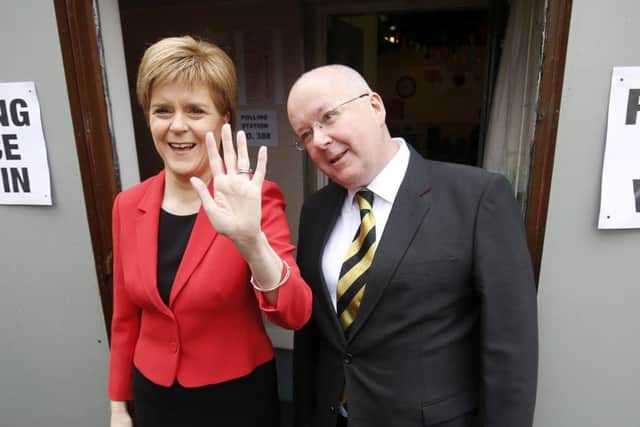Who is Peter Murrell the SNP chief executive and why is he facing calls to quit?
While the role at the top of Scotland’s governing party is not necessarily a high-profile one, Mr Murrell has found himself in the spotlight more than predecessor due to his marriage to First Minister Nicola Sturgeon.
Their relationship and Mr Murrell’s track record came under scrutiny yesterday after former Justice Secretary Kenny MacAskill called on Mr Murrell to ‘move on’ from his role as Chief Executive.


Advertisement
Hide AdAdvertisement
Hide AdMr MacAskill also said that he felt a situation of a husband-and-wife in the top positions of an organisation wouldn’t be tolerated in the media, business, or public sectors.
We look further at one of the most important figures in modern Scottish Politics.
Humble beginnings
Ms Sturgeon married Peter Murrell, who is six years her elder, at a ceremony in Glasgow nine years ago, but the pair had been together since early 2003.
Both met through their work with the party, but while Nicola Sturgeon worked as a lawyer and sought elected office as an MP candidate and then an MSP, her husband worked for the party behind the scenes.
Mr Murell, in a grimly ironic circumstance given the current internal battles at the party, worked at the Banff and Buchan office of then-MP and party leader Alex Salmond.
After a period of ship-steadying under Chief Executive Michael Russell (now the SNP’s Brexit Secretary), Mr Murrell took over the reigns at the head of the party and set about setting the SNP on the long and often arduous path to Government.
Mr Murrell was seen as a calming influence as inter-party strife marked the troubled reign of now-Deputy First Minister John Swinney as leader of the SNP from 2000-20004.
The path to Bute House
It is often forgotten that while eventually running on a joint ticket with returning Alex Salmond, Nicola Sturgeon launched an abortive leadership bid of her own in 2004.
Advertisement
Hide AdAdvertisement
Hide AdMs Sturgeon threw her lot in with Alex Salmond, who handily defeated Roseanna Cunningham and the aforementioned Michael Russell.
Peter Murrell was an important figure in setting up some of the key internal changes that transformed the SNP from an opposition party to one which has governed Scotland for nearly 12 years.
Mr Murell attended the now-infamous Craigellachie Hotel summit in 2005, at which senior SNP figures resolved to ensure that the SNP won the 2007 Scottish election.
He is also credited with steering through the delivery of the ‘Activate’ system, which allowed party activists on the ground to relay voter information back to party HQ.
Controversy
The comments from Kenny MacAskill might have rankled Mr Murrell, but as he approaches 18 years in his role as Chief Executive of the SNP, he has not been immune to criticism.
Eyebrows have been raised within the SNP and elsewhere over the salary of Mr Murrell, which is not disclosed by the party but which has been estimated as totalling upwards of £100,000.
That salary was raised during a fiery Holyrood exchange between Ms Sturgeon and then-Scottish Labour leader Johann Lamont, who said that with a combined salary of well over £200,000, Ms Sturgeon and her husband should not benefit from free prescriptions.
Even in 2014, when Ms Sturgeon was set to ascend unopposed to the party leadership and the role of First Minister, the couple moved to stress that there would be a division of power at the top of the party.
Advertisement
Hide AdAdvertisement
Hide AdNicola Sturgeon told the Herald at the time: “I’ve been deputy leader for years while Peter’s been chief executive for 10 years. That’s not been an issue that’s given rise to any concern internally.
“In the constitution of the SNP, the oversight of the administrative side of the party lies with the business convener, not with the leader. So I’m comfortable there are no issues that arise.”
With the Alex Salmond case, however, questions have again arisen over the concentration of power among a ‘coterie’ of top advisers, including Mr Murrell.
Those questions were first answered in the wake of the SNP’s loss of 21 seats at the snap general election of 2017.
If Kenny MacAskill’s intervention is anything to go by, those questions are only going to get louder and more frequent.
